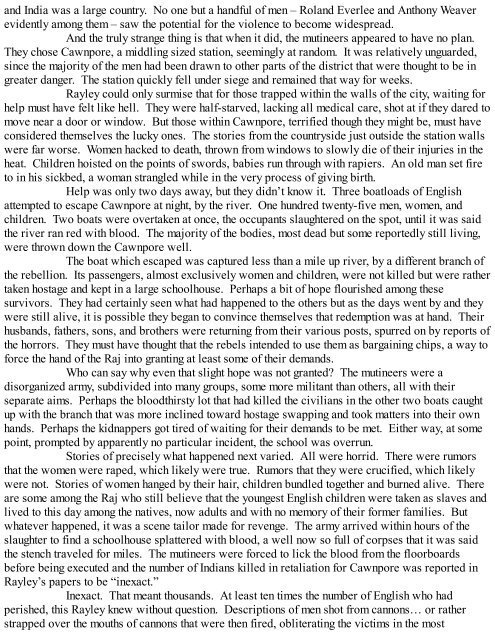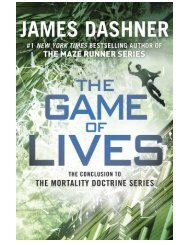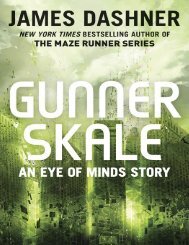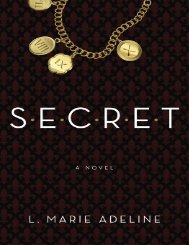You also want an ePaper? Increase the reach of your titles
YUMPU automatically turns print PDFs into web optimized ePapers that Google loves.
and India was a large country. No one but a handful of men – Roland Everlee and Anthony Weaver<br />
evidently among them – saw the potential for the violence to become widespread.<br />
And the truly strange thing is that when it did, the mutineers appeared to have no plan.<br />
They chose Cawnpore, a middling sized station, seemingly at random. It was relatively unguarded,<br />
since the majority of the men had been drawn to other parts of the district that were thought to be in<br />
greater danger. The station quickly fell under siege and remained that way for weeks.<br />
Rayley could only surmise that for those trapped within the walls of the city, waiting for<br />
help must have felt like hell. They were half-starved, lacking all medical care, shot at if they dared to<br />
move near a door or window. But those within Cawnpore, terrified though they might be, must have<br />
considered themselves the lucky ones. The stories from the countryside just outside the station walls<br />
were far worse. Women hacked to death, thrown from windows to slowly die of their injuries in the<br />
heat. Children hoisted on the points of swords, babies run through with rapiers. An old man set fire<br />
to in his sickbed, a woman strangled while in the very process of giving birth.<br />
Help was only two days away, but they didn’t know it. Three boatloads of English<br />
attempted to escape Cawnpore at night, by the river. One hundred twenty-five men, women, and<br />
children. Two boats were overtaken at once, the occupants slaughtered on the spot, until it was said<br />
the river ran red with blood. The majority of the bodies, most dead but some reportedly still living,<br />
were thrown down the Cawnpore well.<br />
The boat which escaped was captured less than a mile up river, by a different branch of<br />
the rebellion. Its passengers, almost exclusively women and children, were not killed but were rather<br />
taken hostage and kept in a large schoolhouse. Perhaps a bit of hope flourished among these<br />
survivors. They had certainly seen what had happened to the others but as the days went by and they<br />
were still alive, it is possible they began to convince themselves that redemption was at hand. Their<br />
husbands, fathers, sons, and brothers were returning from their various posts, spurred on by reports of<br />
the horrors. They must have thought that the rebels intended to use them as bargaining chips, a way to<br />
force the hand of the Raj into granting at least some of their demands.<br />
Who can say why even that slight hope was not granted? The mutineers were a<br />
disorganized army, subdivided into many groups, some more militant than others, all with their<br />
separate aims. Perhaps the bloodthirsty lot that had killed the civilians in the other two boats caught<br />
up with the branch that was more inclined toward hostage swapping and took matters into their own<br />
hands. Perhaps the kidnappers got tired of waiting for their demands to be met. Either way, at some<br />
point, prompted by apparently no particular incident, the school was overrun.<br />
Stories of precisely what happened next varied. All were horrid. There were rumors<br />
that the women were raped, which likely were true. Rumors that they were crucified, which likely<br />
were not. Stories of women hanged by their hair, children bundled together and burned alive. There<br />
are some among the Raj who still believe that the youngest English children were taken as slaves and<br />
lived to this day among the natives, now adults and with no memory of their former families. But<br />
whatever happened, it was a scene tailor made for revenge. The army arrived within hours of the<br />
slaughter to find a schoolhouse splattered with blood, a well now so full of corpses that it was said<br />
the stench traveled for miles. The mutineers were forced to lick the blood from the floorboards<br />
before being executed and the number of Indians killed in retaliation for Cawnpore was reported in<br />
Rayley’s papers to be “inexact.”<br />
Inexact. That meant thousands. At least ten times the number of English who had<br />
perished, this Rayley knew without question. Descriptions of men shot from cannons… or rather<br />
strapped over the mouths of cannons that were then fired, obliterating the victims in the most
















